Incense

Incense is aromatic biotic material which releases fragrant smoke when burned. The term refers to the material itself, rather than to the aroma that it produces. Incense is used for a variety of purposes, including the ceremonies of religion, to overcome bad smells, repel insects, spirituality, aromatherapy, meditation, and for simple pleasure.[1][2][3]
Incense is composed of aromatic plant materials, often combined with essential oils.[4] The forms taken by incense differ with the underlying culture, and have changed with advances in technology and increasing diversity in the reasons for burning it.[5] Incense can generally be separated into two main types: "indirect-burning" and "direct-burning". Indirect-burning incense (or "non-combustible incense") is not capable of burning on its own, and requires a separate heat source. Direct-burning incense (or "combustible incense") is lit directly by a flame and then fanned or blown out, leaving a glowing ember that smoulders and releases fragrance. Direct-burning incense is either a paste formed around a bamboo stick, or a paste that is extruded into a stick or cone shape.
History

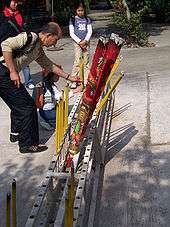
The word incense comes from Latin for incendere meaning "to burn".
Combustible bouquets were used by the ancient Egyptians, who employed incense within both pragmatic and mystical capacities. Incense was burnt to counteract or obscure malodorous products of human habitation, but was widely perceived to also deter malevolent demons and appease the gods with its pleasant aroma.[2] Resin balls were found in many prehistoric Egyptian tombs in El Mahasna, furnishing tangible archaeological substantiation to the prominence of incense and related compounds within Egyptian antiquity.[6] One of the oldest extant incense burners originates from the 5th dynasty.[6] The Temple of Deir-el-Bahari in Egypt contains a series of carvings that depict an expedition for incense.[7]
The Babylonians used incense while offering prayers to divining [8] oracles.[9] Incense spread from there to Greece and Rome.
Incense burners have been found in the Indus Civilization (3300 BCE- 1300 BCE).[10] Evidence suggests oils were used mainly for their aroma. India also adopted techniques from East Asia, adapting the inherited formulation to encompass aromatic roots and other indigenous flora. This comprised the initial usage of subterranean plant parts within the fabrication of incense.[11] New herbs like Sarsaparilla seeds, frankincense, and cypress were used by Indians for incense.[11]
At around 2000 BCE, Ancient China began the use of incense in the religious sense, namely for worship.[12] Incense was used by Chinese cultures from Neolithic times and became more widespread in the Xia, Shang, and Zhou dynasties.[13] The earliest documented instance of incense utilization comes from the ancient Chinese, who employed incense composed of herbs and plant products (such as cassia, cinnamon, styrax, sandalwood, amongst others) as a component of numerous formalized ceremonial rites.[11] Incense usage reached its peak during the Song Dynasty with numerous buildings erected specifically for incense ceremonies.
Brought to Japan in the 6th century by Korean Buddhist monks, who used the mystical aromas in their purification rites, the delicate scents of Koh (high-quality Japanese incense) became a source of amusement and entertainment with nobles in the Imperial Court during the Heian Era 200 years later. During the 14th century Shogunate, a samurai warrior might perfume his helmet and armor with incense to achieve an aura of invincibility (as well as to make a noble gesture to whomever might take his head in battle). It wasn't until the Muromachi Era during the 15th and 16th century that incense appreciation (Kōdō) spread to the upper and middle classes of Japanese society.
Composition

A variety of materials have been used in making incense. Historically there has been a preference for using locally available ingredients. For example, sage and cedar were used by the indigenous peoples of North America.[14] Trading in incense materials comprised a major part of commerce along the Silk Road and other trade routes, one notably called the Incense Route.[15]
The same could be said for the techniques used to make incense. Local knowledge and tools were extremely influential on the style, but methods were also influenced by migrations of foreigners, among them clergy and physicians who were both familiar with incense arts.[5]
Combustible base

The combustible base of a direct burning incense mixture not only binds the fragrant material together but also allows the produced incense to burn with a self-sustained ember, which propagates slowly and evenly through an entire piece of incense with such regularity that it can be used to mark time. The base is chosen such that it does not produce a perceptible smell. Commercially, two types of incense base predominate:
- Fuel and oxidizer mixtures: Charcoal or wood powder forms the fuel for the combustion. Gums such as Gum Arabic or Gum Tragacanth are used to bind the mixture together while an oxidizer such as sodium nitrate or potassium nitrate sustains the burning of the incense. Fragrant materials are combined into the base prior to formation as in the case of powdered incense materials or after formation as in the case of essential oils. The formula for the charcoal-based incense is superficially similar to black powder, though it lacks the sulfur.
- Natural plant-based binders: Mucilaginous material, which can be derived from many botanical sources, is mixed with fragrant materials and water. The mucilage from the wet binding powder holds the fragrant material together while the cellulose in the powder combusts to form a stable ember when lit. The dry binding powder usually comprises about 10% of the dry weight in the finished incense. This includes:
- Makko (incense powder): made from the bark of various trees from the Persea such as Persea thunbergii)
- Xiangnan pi (made from the bark of Phoebe genus trees such as Phoebe nanmu, Persea zuihoensis.
- Jigit: a resin based binder used in India
- Laha or Dar: bark based powders used in Nepal, Tibet, and other East Asian countries.
Types
Incense materials are available in various forms and degrees of processing. They can generally be separated into "direct-burning" and "indirect-burning" types depending on use. Preference for one form or another varies with culture, tradition, and personal taste. Although the production of direct- and indirect-burning incense are both blended to produce a pleasant smell when burned, the two differ in their composition due to the former's requirement for even, stale, and sustained burning.
Indirect-burning
Indirect-burning incense, also called "non-combustible incense",[16] is a combination of aromatic ingredients that are not prepared in any particular way or encouraged into any particular form, leaving it mostly unsuitable for direct combustion. The use of this class of incense requires a separate heat source since it does not generally kindle a fire capable of burning itself and may not ignite at all under normal conditions. This incense can vary in the duration of its burning with the texture of the material. Finer ingredients tend to burn more rapidly, while coarsely ground or whole chunks may be consumed very gradually as they have less total surface area. The heat is traditionally provided by charcoal or glowing embers.
In the West, the best known incense materials of this type are frankincense and myrrh, likely due to their numerous mentions in the Christian Bible. In fact, the word for "frankincense" in many European languages also alludes to any form of incense.
- Whole: The incense material is burned directly in its raw unprocessed form on top of coal embers.
- Powdered or granulated: The incense material is broken down into finer bits. This incense burns quickly and provides a short period of intense smells.
- Paste: The powdered or granulated incense material is mixed with a sticky and incombustible binder, such as dried fruit, honey, or a soft resin and then formed to balls or small pastilles. These may then be allowed to mature in a controlled environment where the fragrances can commingle and unite. Much Arabian incense, also called "Bukhoor" or "Bakhoor", is of this type (Bakhoor actually refers to frankincense in Arabic) and Japan has a history of kneaded incense, called nerikō or awasekō, using this method.[17] Within the Eastern Orthodox Christian tradition, raw frankincense is ground into a fine powder and then mixed with various sweet-smelling essential oils.
Direct-burning

Direct-burning incense also called "combustible incense",[16] is lit directly by a flame. The glowing ember on the incense will continue to smoulder and burn away the rest of the incense without continued application of heat or flame from an outside source. Direct-burning incense is either extruded, pressed into forms, or coated onto a supporting material. This class of incense is made from a moldable substrate of fragrant finely ground (or liquid) incense materials and odourless binder.[5] The composition must be adjusted to provide fragrance in the proper concentration and to ensure even burning. The following types of direct-burning incense are commonly encountered, though the material itself can take virtually any form, according to expediency or whimsy:
- Coil: Extruded and shaped into a coil without a core. This type of incense is able to burn for an extended period, from hours to days, and is commonly produced and used by Chinese culture
- Cone: Incense in this form burns relatively fast. Incense cones were invented in Japan in the 1800s.
- Cored stick: This form of stick incense has a supporting core of bamboo. Higher quality varieties of this form have fragrant sandalwood cores. The core is coated by a thick layer of incense material that burns away with the core. This type of incense is commonly produced in India and China. When used for worship in Chinese folk religion, cored incensed sticks are sometimes known as "joss sticks".
- Solid stick: This stick incense has no supporting core and is completely made of incense material. Easily broken into pieces, it allows one to determine the specific amount of incense they wish to burn. This is the most commonly produced form of incense in Japan and Tibet.
- Powder: The loose incense powder used for making indirect burning incense is sometimes burned without further processing. They are typically packed into long trails on top of wood ash using a stencil and burned in special censers or incense clocks.
- Paper: Paper infused with incense, folded accordion style, lit and blown out. Examples are Carta d'Armenia and Papier d'Arménie.
- Rope: The incense powder is rolled into paper sheets, which are then rolled into ropes, twisted tightly, then doubled over and twisted again, yielding a two-strand rope. The larger end is the bight, and may be stood vertically, in a shallow dish of sand or pebbles. The smaller (pointed) end is lit. This type of incense is highly transportable and stays fresh for extremely long periods. It has been used for centuries in Tibet and Nepal.
The disks of powdered mugwort called 'moxa' sold in Chinese shops and herbalists are used in Traditional Chinese medicine for moxibustion treatment. Moxa tablets are not incenses; the treatment relies on heat rather than fragrance.
Reed diffusing
A reed diffuser is a form of incense that uses no heat. It comes in three parts: a bottle/container, scented essential incense oil, and bamboo reeds. The incense oil is placed into the container and bamboo reeds are then put into the same container. This is done to absorb some of the incense oil, as well as to help carry its scent and essence out of the container and into the surrounding air. Reeds typically have tiny tube openings that run the entire length of the stick. Oil is absorbed by the reed sticks and carried along the entire reed. These are do-it-yourself incense sticks that do not burn and look almost identical to typical incense sticks.
Production
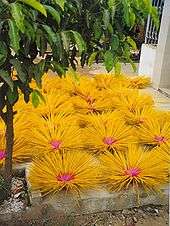
Indirect burning
The raw materials are powdered and then mixed together with a binder to form a paste, which, for direct burning incense, are then cut and dried into pellets. Incense of the Athonite Orthodox Christian tradition are made by powdering frankincense or fir resin, mixing it with essential oils. Floral fragrances are the most common, but citrus such as lemon is not uncommon. The incense mixture is then rolled out into a slab approximately 1 cm thick and left until the slab has firmed. It is then cut into small cubes, coated with clay powder to prevent adhesion, and allowed to fully harden and dry.[18][19] In Greece this rolled incense resin is called 'Moskolibano', and generally comes in either a pink or green colour denoting the fragrance, with pink being rose and green being jasmine.
Direct burning

In order to obtain desired combustion qualities, attention has to be paid to certain proportions in direct burning incense mixtures:
- Oil content: Resinous materials such as myrrh and frankincense must not exceed the amount of dry materials in the mixture to such a degree that the incense will not smolder and burn. The higher the oil content relative to the dry mass, the less likely the mixture is to burn effectively. Typically the resinous or oily substances are balanced with "dry" materials such as wood, bark and leaf powders.
- Oxidizer quantity: The amount of chemical oxidizer in gum-bound incense must be carefully proportioned. If too little, the incense will not ignite, and if too much, the incense will burn too quickly and not produce fragrant smoke.
- Mixture density: Incense mixtures made with natural binders must not be combined with too much water in mixing, or over-compressed while being formed, which would result in either uneven air distribution or undesirable density in the mixture, causing the incense to burn unevenly, too slowly, or too quickly.
- Particulate size: The incense mixture has to be well pulverized with similarly sized particulates. Uneven and large particulates result in uneven burning and inconsistent aroma production when burned.
- Binder: Water-soluble binders such as "makko" have to be used in the right proportion to ensure that the incense mixture does not crumble when dry but also that the binder does not take up too much of the mixture.[5]
Some kinds of direct-burning incense are created from "incense blanks" made of unscented combustible dust immersed into any suitable kind of essential or fragrance oil. These are often sold in America by flea-market and sidewalk vendors who have developed their own styles. Such items are often known as "dipped" or "hand-dipped" incense. This form of incense requires the least skill and equipment to manufacture, since the blanks are pre-formed in China or South East Asia, then simply scented with essential oils.
Incense mixtures can be extruded or pressed into shapes. Small quantities of water are combined with the fragrance and incense base mixture and kneaded into a hard dough. The incense dough is then pressed into shaped forms to create cone and smaller coiled incense, or forced through a hydraulic press for solid stick incense. The formed incense is then trimmed and slowly dried. Incense produced in this fashion has a tendency to warp or become misshapen when improperly dried, and as such must be placed in climate-controlled rooms and rotated several times through the drying process.
Traditionally, the bamboo cores of cored stick incense is prepared by hand from Phyllostachys heterocycla cv. pubescens since this species produces thick wood and easily burns to ashes in the incense stick.[20] Through this process, known as "splitting the foot of the incense stick", the bamboo is trimmed to length, soaked, peeled, and then continuously split in halves until thin sticks of bamboo with square cross sections of less than 3mm [21][22] This process has been largely been replaced by machines in modern incense production.[23]
In the case of cored incensed sticks, several methods are employed to coat the sticks cores with incense mixture:
- Paste rolling: A wet, malleable paste of incense mixture is first rolled into a long, thin coil, using a paddle. Then, a thin stick is put next to the coil and the stick and paste are rolled together until the stick is centered in the mixture and the desired thickness is achieved. The stick is then cut to the desired length and dried.[24]
- Powder-coating: Powder-coating is used mainly to produce cored incense of either larger coil (up to 1 meter in diameter) or cored stick forms. A bundle of the supporting material (typically thin bamboo or sandalwood slivers) is soaked in water or a thin water/glue mixture for a short time. The thin sticks are then evenly separated, then dipped into a tray of incense powder, consisting of fragrance materials and occasionally a plant-based binder. The dry incense powder is then tossed and piled over the stick while they are spread apart. The sticks are then gently rolled and packed to maintain roundness while more incense powder is repeatedly tossed onto the sticks. Three to four layers of powder are coated onto the sticks, forming a 2 mm thick layer of incense material on the stick. The coated incense is then allowed to dry in open air. Additional coatings of incense mixture can be applied after each period of successive drying. Incense sticks that are burned in temples of Chinese folk religion produced in this fashion can have a thickness between 2 and 4 millimeters.[25][26]
- Compression: A damp powder is mechanically formed around a cored stick by compression, similar to the way uncored sticks are formed. This form is becoming more commonly found due to the higher labor cost of producing powder-coated or paste-rolled sticks.
Joss sticks

Joss sticks are the name given to incense sticks used for a variety of purposes associated with ritual and religious devotion in China and India. They are used in Chinese influenced East Asian and Southeast Asian countries, traditionally burned before the threshold of a home or business, before an image of a Chinese popular religion divinity or spirit of place, or in small and humble or large and elaborate shrine found at the main entrance to each and every village. Here the earth god is propitiated in the hope of bringing wealth and health to the village. They can also be burned in front of a door, or open window as an offering to heaven, or devas. The word "joss" is derived from the Latin deus (god) via the Portuguese deos through the Javanese dejos, through Chinese pidgin English.[27][28]
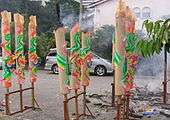
Joss-stick burning is an everyday practice in traditional Chinese religion. There are many different types of joss sticks used for different purposes or on different festive days. Many of them are long and thin and are mostly colored yellow, red, and more rarely, black. Thick joss sticks are used for special ceremonies, such as funerals. Spiral joss sticks are also used on a regular basis, which are found hanging above temple ceilings, with burn times that are exceedingly long. In some states, such as Taiwan, Singapore, or Malaysia, where they celebrate the Ghost Festival, large, pillar-like dragon joss sticks are sometimes used. These generate such a massive amount of smoke and heat that they are only ever burned outside.

Chinese incense sticks for use in popular religion are generally without aroma or only the slightest trace of jasmine or rose, since it is the smoke, not the scent, which is important in conveying the prayers of the faithful to heaven. They are composed of the dried powdered bark of a non-scented species of cinnamon native to Cambodia, Cinnamomum cambodianum. Inexpensive packs of 300 are often found for sale in Chinese supermarkets. Despite the fact that they contain no sandalwood at all, they often include the Chinese character for sandalwood on the label, as a generic term for incense.
Highly scented Chinese incense sticks are only used by some Buddhists. These are often quite expensive due to the use of large amounts of sandalwood, aloeswood, or floral scents used. The Sandalwood used in Chinese incenses does not come from India, its native home, but rather from groves planted within Chinese territory. Sites belonging to Tzu Chi, Chung Tai Shan, Dharma Drum Mountain,[29] Xingtian Temple,[30] Buddhism in Sri Lanka, Buddhism in Burma and Korean Buddhism do not use incense.[31][32]
Burning incense
For indirect-burning incense, pieces of the incense are burned by placing them directly on top of a heat source or on a hot metal plate in a censer or thurible.[33]
In Japan a similar censer called a egōro (柄香炉) is used by several Buddhist sects. The egōro is usually made of brass with a long handle and no chain. Instead of charcoal, makkō powder is poured into a depression made in a bed of ash. The makkō is lit and the incense mixture is burned on top. This method is known as Sonae-kō (Religious Burning).[34]
For direct-burning incense, the tip or end of the incense is ignited with a flame or other heat source until the incense begins to turn into ash at the burning end. Flames on the incense are then fanned or blown out, with the incense continuing to burn without a flame on its own.
Cultural variations
Chinese incense
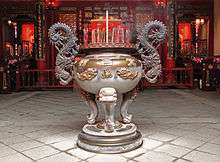
For over two thousand years, the Chinese have used incense in religious ceremonies, ancestor veneration, Traditional Chinese medicine, and daily life.
Agarwood (chénxiāng) and sandalwood (tánxiāng) are the two most important ingredients in Chinese incense.
Along with the introduction of Buddhism in China came calibrated incense sticks and incense clocks.[35] The poet Yu Jianwu (487-551) first recorded them: "By burning incense we know the o'clock of the night, With graduated candles we confirm the tally of the watches."[36] The use of these incense timekeeping devices spread from Buddhist monasteries into Chinese secular society.
It is incorrect to assume that the Chinese only burn incense in the home before the family shrine. In Taoist traditions, incense is inextricably associated with the 'yin' energies of the dead, temples, shrines, and ghosts. Therefore, Taoist Chinese believe burning undedicated incense in the home attracts the dreaded hungry ghosts, who consume the smoke and ruin the fortunes of the family.
However, since Neolithic times, the Chinese have evolved using incense not only for religious ceremonies, but also for personal and environmental aromatherapy.
Indian incense

Incense stick, also known as agarbathi (or agarbatti) and joss sticks, in which an incense paste is rolled or moulded around a bamboo stick, is one of the main forms of incense in India. The bamboo method originated in India, and is distinct from the Nepal/Tibet and Japanese methods of stick making which don't use a bamboo core. Though the method is also used in the west, particularly in America, it is strongly associated with India.
The basic ingredients are the bamboo stick, the paste (generally made of charcoal dust and joss/jiggit/gum/tabu powder - an adhesive made from the bark of litsea glutinosa and other trees),[37] and the perfume ingredients - which would be a masala (spice mix) powder of ground ingredients into which the stick would be rolled, or a perfume liquid sometimes consisting of synthetic ingredients into which the stick would be dipped. Perfume is sometimes sprayed on the coated sticks. Stick machines are sometimes used, which coat the stick with paste and perfume, though the bulk of production is done by hand rolling at home. There are about 5,000 incense companies in India which take raw unperfumed sticks hand-rolled by approx 200,000 women working part-time at home, and then apply their own brand of perfume, and package the sticks for sale.[38] An experienced home-worker can produce 4,000 raw sticks a day.[39] There are about 50 main companies who together account for up to 30% of the market, and around 500 of the companies, including a significant number of the main ones, including Moksh Agarbatti and Cycle Pure,[40] are based in Bangalore.[41]
In the Middle East, incense burning has been along tradition. The word bukhur means incense in Arabic. The well known choice for incense is the famous agarwood which is very popular in Africa, the Gulf and amongst some south Asians, but there are many many more choices. Incense come in a variety of forms such as blocks, pieces, pellets, granules or powdered, which is placed in the oil burner called mabkharah for several minutes to heat either with coal in the traditional way or via power in the modern way, allowing it to release its rich smell. However this takes awhile and the quick alternative is to use incense sticks called Oud in Middle East and Africa, and agarbatti in south Asia - again referring to the agar wood + batti meaning some sort of agar-stick. Occasionally some get confused between bukhur and oud, bukhur is the insence ie agarwood, sandlewood etc and oud being the incense sticks (and not the otherway round sometimes wires get twisted)
Jerusalem temple incense
Ketoret was the incense offered in the Temple in Jerusalem and is stated in the Book of Exodus as a mixture of stacte, onycha, galbanum and frankincense.[42]
Tibetan incense
Tibetan incense refers to a common style of incense found in Tibet, Nepal, and Bhutan. These incenses have a characteristic "earthy" scent to them. Ingredients vary from cinnamon, clove, and juniper, to kusum flower, ashvagandha, or sahi jeera.
Many Tibetan incenses are thought to have medicinal properties. Their recipes come from ancient Vedic texts that are based on even older Ayurvedic medical texts. The recipes have remained unchanged for centuries.
Japanese incense
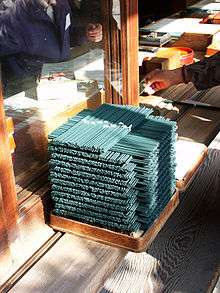
In Japan incense appreciation folklore includes art, culture, history, and ceremony. It can be compared to and has some of the same qualities as music, art, or literature. Incense burning may occasionally take place within the tea ceremony, just like Calligraphy, Ikebana, and Scroll Arrangement. However the art of incense appreciation or Koh-do, is generally practiced as a separate art form from the tea ceremony, however usually practiced within a tea room of traditional Zen design.
Agarwood (沈香 Jinkō) and sandalwood (白檀 Byakudan) are the two most important ingredients in Japanese incense. Agarwood is known as "Jinkō" in Japan, which translates as "incense that sinks in water", due to the weight of the resin in the wood. Sandalwood is one of the most calming incense ingredients and lends itself well to meditation. It is also used in the Japanese tea ceremony. The most valued Sandalwood comes from Mysore in the state of Karnataka in India.
Another important ingredient in Japanese incense is kyara (伽羅). Kyara is one kind of agarwood (Japanese incense companies divide agarwood into 6 categories depending on the region obtained and properties of the agarwood). Kyara is currently worth more than its weight in gold.
Some terms used in Japanese incense culture include:
- Incense Arts: [香道, Kodo]
- Agarwood: [ 沈香 ] – from heartwood from Aquilaria trees, unique, the incense wood most used in incense ceremony, other names are: lignum aloes or aloeswood, gaharu, jinko, or oud.
- Censer/Incense burner: [香爐] – usually small and used for heating incense not burning, or larger and used for burning
- Charcoal: [木炭] – only the odorless kind is used.
- Incense woods: [ 香木 ] – a naturally fragrant resinous wood.
Usage
Incense is used for a variety of purposes, including the ceremonies of all the main religions, to overcome bad smells, repel insects, purify or improve the atmosphere, aromatherapy, meditation, and for simple pleasure.[1][2][3][43]
- Practical
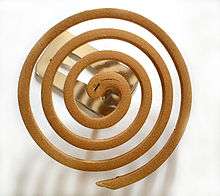
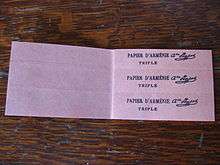
Incense fragrances can be of such great strength that they obscure other, less desirable odours. This utility led to the use of incense in funerary ceremonies because the incense could smother the scent of decay. Another example of this use, as well as of religious use, is the giant Botafumeiro thurible which swings from the ceiling of the Cathedral of Santiago de Compostela. It is used in part to mask the scent of the many tired, unwashed pilgrims huddled together in the Cathedral of Santiago de Compostela.[42]
A similar utilitarian use of incense can be found in the post-Reformation Church of England. Although the ceremonial use of incense was abandoned until the Oxford Movement, it was common to have incense (typically frankincense) burned before grand occasions, when the church would be crowded. The frankincense was carried about by a member of the vestry before the service in a vessel called a 'perfuming pan'. In iconography of the day, this vessel is shown to be elongated and flat, with a single, long handle on one side. It is important to note that the perfuming pan was used instead of the thurible, as the latter would have likely offended the Protestant sensibilities of the 17th and 18th centuries.
The regular burning of direct combustion incense has been used for chronological measurement in incense clocks. These devices can range from a simple trail of incense material calibrated to burn in a specific time period, to elaborate and ornate instruments with bells or gongs, designed to involve and captivate several of the senses.[44]
Incense made from materials such as citronella can repel mosquitoes and other aggravating, distracting or pestilential insects. This use has been deployed in concert with religious uses by Zen Buddhists who claim that the incense that is part of their meditative practice is designed to keep bothersome insects from distracting the practitioner. Currently, more effective pyrethroid-based mosquito repellent incense is widely available in Asia.
Papier d'Arménie was originally sold as a disinfectant as well as for the fragrance.
Incense is also used often by people who smoke indoors, and do not want the scent to linger.
- Aesthetic
Many people burn incense to appreciate its smell, without assigning any other specific significance to it, in the same way that the foregoing items can be produced or consumed solely for the contemplation or enjoyment of the refined sensory experience. This use is perhaps best exemplified in the kōdō (香道), where (frequently costly) raw incense materials such as agarwood are appreciated in a formal setting.
- Religious
Use of incense in religion is prevalent in many cultures and may have their roots in the practical and aesthetic uses considering that many religions with not much else in common all use incense. One common motif is incense as a form of sacrificial offering to a deity. Such use was common in Judaic worship [42] and remains in use for example in the Catholic, Orthodox, and Anglican churches, Taoist and Buddhist Chinese jingxiang (敬香 "offer incense [to ancestors/gods]), etc.
Health
Incense smoke contains various contaminants including gaseous pollutants, such as carbon monoxide (CO), nitrogen oxides (NOx), sulfur oxides (SOx), volatile organic compounds (VOCs) [4–8], and absorbed toxic pollutants (polycyclic aromatic hydrocarbons and toxic metals). The solid particles range between ~10 and 500 nm. The emission rate decreases in the row Indian sandalwood > Japanese aloeswood > Taiwanese aloeswood > smokeless sandalwood.[45]
Research carried out in Taiwan in 2001 linked the burning of incense sticks to the slow accumulation of potential carcinogens in a poorly ventilated environment by measuring the levels of polycyclic aromatic hydrocarbons (including benzopyrene) within Buddhist temples. The study found gaseous aliphatic aldehydes, which are carcinogenic and mutagenic, in incense smoke.[46]
A survey of risk factors for lung cancer, also conducted in Taiwan, noted an inverse association between incense burning and adenocarcinoma of the lung, though the finding was not deemed significant.[47]
In contrast, a study by several Asian Cancer Research Centers showed: "No association was found between exposure to incense burning and respiratory symptoms like chronic cough, chronic sputum, chronic bronchitis, runny nose, wheezing, asthma, allergic rhinitis, or pneumonia among the three populations studied: i.e. primary school children, their non-smoking mothers, or a group of older non-smoking female controls. Incense burning did not affect lung cancer risk among non-smokers, but it significantly reduced risk among smokers, even after adjusting for lifetime smoking amount." However, the researchers qualified the findings by noting that incense burning in the studied population was associated with certain low-cancer-risk dietary habits, and concluded that "diet can be a significant confounder of epidemiological studies on air pollution and respiratory health."[48]
Although several studies have not shown a link between incense and cancer of the lung, many other types of cancer have been directly linked to burning incense. A study published in 2008 in the medical journal Cancer found that incense use is associated with a statistically significant higher risk of cancers of the upper respiratory tract, with the exception of nasopharyngeal cancer. Those who used incense heavily also had higher rates of a type of cancer called squamous-cell carcinoma, which refers to tumors that arise in the cells lining the internal and external surfaces of the body. The link between incense use and increased cancer risk held when the researchers weighed other factors, including cigarette smoking, diet and drinking habits. The research team noted that "This association is consistent with a large number of studies identifying carcinogens in incense smoke, and given the widespread and sometimes involuntary exposure to smoke from burning incense, these findings carry significant public health implications."[49]
In 2015, the South China University of Technology found toxicity of incense to Chinese hamsters ovary cells to be even higher than cigarettes. [50]
Frankincense has been shown to cause antidepressive behavior in mice. It activated the poorly understood ion channels in the brain to alleviate anxiety and depression.[51]
See also
- Incense Route
- Kōbako
- Kōdō, incense arts
- Kyphi
- Silk Road
- Smudge stick
- Bukhoor
References
- 1 2 Gina Hyams; Susie Cushner (2004). Incense: Rituals, Mystery, Lore. Chronicle Books. ISBN 0-8118-3993-1.
- 1 2 3 Maria Lis-Balchin (2006). Aromatherapy science: a guide for healthcare professionals. Pharmaceutical Press. ISBN 0-85369-578-4.
- 1 2 Malcolm Harper (2010). Inclusive Value Chains: A Pathway Out of Poverty. World Scientific. p. 247. ISBN 9789814295000. Retrieved 4 August 2013.
- ↑ Cunningham's Encyclopedia of magical herbs. Llewellyn Worldwide. 2000. ISBN 0-87542-122-9.
- 1 2 3 4 "baieido-incense". Oller.net. Retrieved 2016-07-20.
- 1 2 Nielsen, Kjeld (1986). Incense in ancient Israel. p. 3. ISBN 9004077022.
- ↑ Stoddart, D. Michael (1990). The scented ape: The biology and culture of human odour. Cambridge: Cambridge University Press. p. 171. ISBN 0-521-37511-8.
- ↑ http://incensecandlesadvice.blogspot.com/2016/09/catholic-incense-rituals-and-using.html
- ↑ Foreign trade in the old Babylonian period: as revealed by texts from southern Mesopotamia. Brill Archive. 1960.
- ↑ John Marshall (1996). Mohenjo Daro And The Indus Civilization 3 Vols. Asian Educational Services. ISBN 81-206-1179-9.
- 1 2 3 Stoddart, D. Michael (1990). The scented ape: The biology and culture of human odour. Cambridge: Cambridge University Press. p. 169. ISBN 0-521-37511-8.
- ↑ Herrera, Matthew D. (2012). Holy Smoke: The Use of Incense in the Catholic Church (2nd ed.). San Luis Obispo: Tixlini Scriptorium. Page 1.
- ↑ "中華東方香學研究會 ∙ 官方網站| Chinese Incense Art Association ∙ Official Website". Incenseart.org.tw. Retrieved 2016-07-20.
- ↑ Adrienne Borden; Steve Coyote. "The Smudging Ceremony".
- ↑ Herrera, Matthew D. Holy Smoke: The Use of Incense in the Catholic Church. San Luis Obispo: Tixlini Scriptorium, 2011. www.SmellsBells.com
- 1 2 "How to Make Incense". Scents-of-earth.com. Retrieved 2016-07-20.
- ↑ "Incense blending contents". ancientworlds.net. April 28, 2004. Archived from the original on June 14, 2011.
- ↑ "Incense - United States". Orthodox Incense. 2013-08-12. Retrieved 2016-07-20.
- ↑ "Incense". OrthodoxWiki.org. 2011-11-06. Retrieved 2016-07-20.
- ↑ Chen(陳), Ka-Yan(家恩), Joss Stick Manufacturing: A Study of a Traditional Industry in Hong Kong (PDF), sunzi1.lib.hku.hk
- ↑ "雲霄古道/溫蕉厝的剖香腳". YouTube. Retrieved 2016-07-20.
- ↑ 陳, 永順 (2010-03-07), "失落百年 「剖香腳」技藝重現", 聯合報, 聯合新聞網
- ↑ "YouTube". YouTube. Retrieved 2016-07-20.
- ↑ "Making Incense". YouTube. 2006-12-18. Retrieved 2016-07-20.
- ↑ "台灣宏觀電視TMACTV 代代相傳 新港香". YouTube. Retrieved 2016-07-20.
- ↑ "製香過程". YouTube. 2009-07-20. Retrieved 2016-07-20.
- ↑ "Joss | Define Joss at Dictionary.com". Dictionary.reference.com. Retrieved 2016-07-20.
- ↑ Harper, Douglas. "joss". Online Etymology Dictionary.
- ↑ TOP. "不燒香 法鼓山行之有年 | 生活 | 中央社即時新聞 CNA NEWS". Cna.com.tw. Retrieved 2016-07-20.
- ↑ "我們都誤會行天宮了 | 即時新聞 | 20140901 | 蘋果日報". Appledaily.com.tw. Retrieved 2016-07-20.
- ↑ 作者:廣興. "香港宝莲禅寺佛教文化传播网". Hk.plm.org.cn. Retrieved 2016-07-20.
- ↑ "全球买家•缅甸 缅甸:谈生意莫选星期二". Ycwb.com. 2005-11-14. Retrieved 2016-07-20.
- ↑ P. Morrisroe. Transcribed by Kevin Cawley. "Catholic Encyclopedia".
- ↑ Japanese-Incense. "Buddhist Incense – Sonae ko".
- ↑ Bedini, Silvio A. (1963). "The Scent of Time. A Study of the Use of Fire and Incense for Time Measurement in Oriental Countries". Transactions of the American Philosophical Society. Philadelphia, Pennsylvania: American Philosophical Society. 53 (5): 1–51. doi:10.2307/1005923. JSTOR 1005923.
- ↑ Schafer, Edward H. (1963). The Golden Peaches of Samarkand, a Study of T'ang Exotics. University of California Press. p. 155.
- ↑ Jonathan Mitchell; Christopher Coles (2011). Markets and Rural Poverty: Upgrading in Value Chains. IDRC. p. 50. ISBN 9781849713139. Retrieved 5 August 2013.
- ↑ Malcolm Harper (2010). Inclusive Value Chains: A Pathway Out of Poverty. World Scientific. p. 249. ISBN 9789814295000. Retrieved 4 August 2013.
- ↑ Mark Holmström (3 Dec 2007). South Indian Factory Workers: Their Life and Their World. Cambridge University Press. p. 16. ISBN 9780521048125. Retrieved 5 August 2013.
- ↑ "Incense Sticks Manufacturers, Suppliers and Exporters | Moksh". Mokshagarbatti.com. 2014-06-20. Retrieved 2016-07-20.
- ↑ B. Sudhakara Reddy (1 Jan 1998). Urban Energy Systems. Concept Publishing Company. p. 84. ISBN 9788170226819. Retrieved 5 August 2013.
- 1 2 3 Herrera, Matthew D. (2011). "Holy Smoke: The Use of Incense in the Catholic Church" (PDF). San Luis Obispo: Tixlini Scriptorium.
- ↑ Carl Neal (2003). Incense: Crafting & Use of Magickal Scents. Llewellyn Worldwide. ISBN 0-7387-0336-2.
- ↑ Silvio A. Bedini. "Time Measurement With Incense in Japan".
- ↑ Siao Wei See; et al. (2007). "Physical characteristics of nanoparticles emitted from incense smoke". Science and Technology of Advanced Materials (free download). 8 (1–2): 25–32. doi:10.1016/j.stam.2006.11.016.
- ↑ Lin, J M; L H Wang (September 1994). "Gaseous aliphatic aldehydes in Chinese incense smoke". Bulletin of Environmental Contamination and Toxicology. 53 (3): 374–381. doi:10.1007/bf00197229. ISSN 0007-4861. PMID 7919714.
- ↑ Ger LP, Hsu WL, Chen KT, Chen CJ; Hsu; Chen; Chen (1993). "Risk factors of lung cancer by histological category in Taiwan". Anticancer Res. 13 (5A): 1491–500. PMID 8239527.
- ↑ Koo, Linda C.; Ho, J.H-C.; Tominaga, Suketami; Matsushita, Hidetsuru; Matsuki, Hideaki; Shimizu, Hiroyuki; Mori, Toru (1995-11-01). "Is Chinese Incense Smoke Hazardous to Respiratory Health?: Epidemiological Results from Hong Kong". Indoor and Built Environment. 4 (6): 334–343. doi:10.1177/1420326X9500400604.
- ↑ "Burning incense linked to respiratory cancers". Reuters. 2008-08-25. Retrieved 2016-07-20.
- ↑ "Higher cytotoxicity and genotoxicity of burning incense than cigarette". Environmental Chemistry Letters. 13: 465–471. doi:10.1007/s10311-015-0521-7.
- ↑ Moussaieff A, Rimmerman N, Bregman T, et al. (August 2008). "Incensole acetate, an incense component, elicits psychoactivity by activating TRPV3 channels in the brain". FASEB J. 22 (8): 3024–34. doi:10.1096/fj.07-101865. PMC 2493463
 . PMID 18492727.
. PMID 18492727.
Further reading
- Silvio A. Bedini. (1994). "The Trail of Time: Time Measurement with Incense in East Asia". Cambridge University Press. ISBN 0-521-37482-0
External links
- Photo Project about Incense Offering on Chinese New Year
- Movie about making Tibetan Incense in Nepal
| Wikimedia Commons has media related to Incense. |
